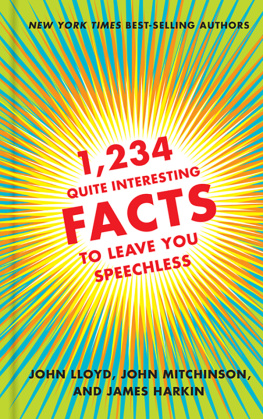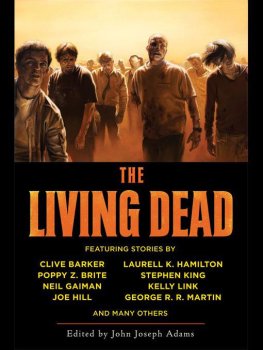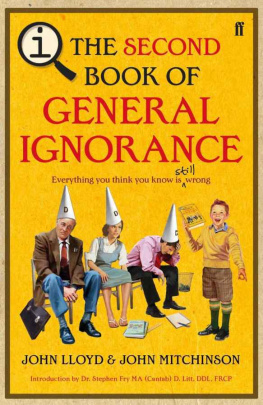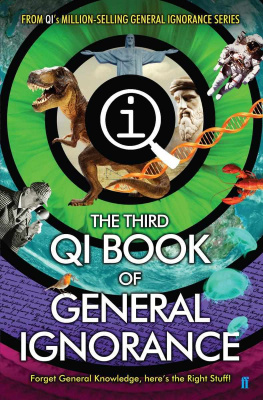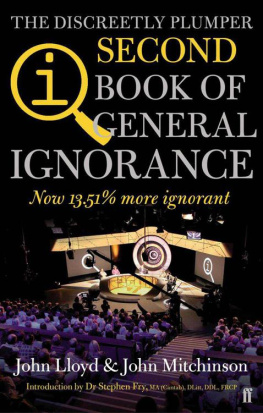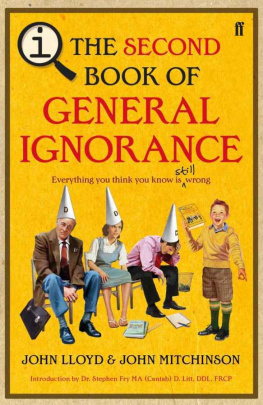Also by John Lloyd and John Mitchinson
THE BOOK OF GENERAL IGNORANCE
THE BOOK OF ANIMAL IGNORANCE
IF IGNORANCE IS BLISS, WHY ARENT THERE MORE HAPPY PEOPLE?
Also by John Lloyd (with Douglas Adams)
THE MEANING OF LIFF THE
DEEPER MEANING OF LIFF
Copyright 2009 QI Ltd.
All rights reserved.
Published in the United States by Crown Publishers,
an imprint of the Crown Publishing Group, a division of
Random House, Inc., New York.
www.crownpublishing.com
Crown and the Crown colophon
are registered trademarks of Random House, Inc.
Originally published in Great Britain as The QI Book of the Dead
by Faber and Faber Ltd, London, in 2009.
Library of Congress Cataloging-in-Publication Data
Mitchinson, John, 1963
The book of the dead / John Mitchinson & John Lloyd.1st ed.
p. cm.
Originally published: London : Faber and Faber, 2009.
1. BiographyAnecdotes. 2. Anecdotes. I. Lloyd, John, 1951 II. Title.
CT109.M58 2010
920dc22 2010004609
eISBN: 978-0-307-71641-5
v3.1
Contents
1 Theres Nothing Like a Bad Start in Life
Leonardo da VinciSigmund FreudIsaac NewtonOliver HeavisideLord ByronAda LovelaceHans Christian AndersenSalvador Dal
2 Happy-go-lucky
EpicurusBenjamin FranklinEdward JennerMary SeacoleMoll CutpurseRichard Feynman
3 Driven
Genghis KhanRobert E. PearyMary KingsleyAlexander von HumboldtFrancis GaltonWilliam Morris
4 Lets Do It
Giacomo CasanovaCatherine the GreatCora PearlH. G. WellsColetteMarie BonaparteAlfred KinseyTallulah Bankhead
5 Man Cannot Live by Bread Alone
Helena, Comtesse de NoaillesGeorge FordyceElizabeth, Empress of AustriaDr. John Harvey KelloggHenry FordGeorge Washington CarverHoward Hughes
6 Grin and Bear It
Pieter StuyvesantGeneral Antonio Lpez de Santa AnnaDaniel LambertFlorence NightingaleFernando PessoaDawn Langley Simmons
7 The Monkey Keepers
Oliver CromwellCatherine de MediciSir Jeffrey HudsonRembrandt van RijnFrida KahloMadame MaoFrank BucklandKing Alexander I of Greece
8 Who Do You Think You Are?
Titus OatesAlessandro, Count CagliostroGeorge PsalmanazarPrincess CarabooLouis de RougemontJames BarryIgncz Trebitsch LincolnTuesday Lobsang RampaArchibald Belaney
9 Once Youre Dead, Youre Made for Life
Emma HamiltonDr. John DeeJack ParsonsNikola TeslaKarl Marx
10 Is That All There Is?
St. CuthbertAnn LeeWilliam BlakeJeremy BenthamRichard Buckminster Fuller
Introduction
This is a city of shifting light, of changing skies, of sudden vistas.
A city so beautiful it breaks the heart again and again.
ALEXANDER MCCALL SMITH
G eorge Street in Edinburgh is one of the most elegant thoroughfares in one of the best-designed cities in the world. Wherever you stand along it, at one end can be seen the green copper dome of a Robert Adam church called St. Georges and, at the other, a massive stone column called the Melville Monument.
Loosely modeled on Trajans Column in Rome, it is not quite as tall as Nelsons Column in London but it is equally striking and certainly more beautifully situated. The architect was William Burn (17891870) but he had more than a little help from Robert Stevenson (17721850), the great Scottish civil engineer, better known for his roads, harbors, and bridgesand especially for his daring and spectacular lighthouses. According to the metal plaque near the base of the column, Stevenson finalised the dimensions and superintended the building of this 140-foot-high, 1,500-ton edifice utilising the worlds first iron balance-crane, invented under his direction by Francis Watt in 180910 for erecting the Bell Rock lighthouse.
And yet, unless you are a resident of the Scottish capital, or a naval historian specializing in the Napoleonic wars, it is my guess that you have never even heard of him.
Lifewhats it all about, eh?
In Edinburgh, early one sunny morning last August, I was standing at the east end of George Street looking into St. Andrew Square, where Dundass memorial stands. The huge fluted edifice rose, dark against the recently risen sun, into the watercolor sky. As I watched, across the grass still bright with dew, ran a small girl, no more than four years old. She was alone, wearing a pink top and white jeans, with blond Shirley Temple curls. She rushed toward the immense column and, when she was a few yards away, she stopped. She looked slowly up its gigantic length till the angle of her head told me she was staring at the blackened figure on the top. Her back was to meI never saw her facebut from the whole attitude of her body it was obvious that she was awestruck. It was the perfect photograph. Though I didnt have a camera with me, I can still see it in my minds eye as clearly as if it were on the screen in front of me now. It also seemed to be the perfect metaphor. Here were the two bookends of human life. Far up in the sky, long dead, a great stone man whose name very few of us now know; below, still earthbound, still with everything to live for, a tiny real human being whose name is completely unknown to all of us (including me) but who has the potential, if she but knew it, to become the most famous woman in history.
Perhaps in those few moments, staring at the forbidding personage in the sky, something turned over in the tumblers of her brain, opening a hidden lock and inspiring her to future greatness. Or, perhaps, at some subconscious level, she suddenly came to the same conclusion as the Greek philosopher Epictetus: that fame is the noise of madmen. After all, it is not necessary for the world to know who you are to live a good and worthwhile life.
John Mitchinson and I hope that you may be inspired to greatness by the journeys of the three score and eight extraordinary human beings here within, or at least draw some comfort from knowing your life is nowhere near as bad as it could be.
JOHN LLOYD
Impeachment is the process of putting a public official on trial for improper conduct (in this case corruption and misappropriation of public funds) with the intent of removing him or her from office. The House of Lords acquitted Dundas (and offered him an Earldom by way of apology), but he never held office again.
Prologue
I dont think anybody should write his autobiography until after he is dead.
SAMUEL GOLDWYN
T he first thing that strikes you about the Dead is just how many of them there are. The idea you hear bandied about that there are more people living now than have ever lived in the past is plain wrongby a factor of thirteen. The number of Homo sapiens sapiens who have ever lived, fought, loved, fussed, and finally died over the last hundred thousand years is around 90 billion.
Ninety billion is a big number, especially when youre trying to write a book with a title that implies it covers all of them. But it all depends how you look at things. Ninety billion is big, but also small. You could bury everyone who has ever lived, side by side, in an area the size of England and Scotland combined. Or Uruguay. Or Oklahoma. Thats just 0.1 percent of the land area of the earth. And if you piled all the dead people who have ever lived on to an enormous set of scales, they would be comfortably outweighed by the ants that are out there right now, plotting who knows what. Its all a question of perspective.


